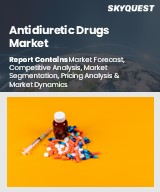
세계의 항이뇨제 시장 규모는 2023년에 17억 달러로 평가되며, 2024년 18억 달러에서 2032년에는 30억 5,000만 달러로 성장하며, 예측 기간(2025-2032년)의 CAGR은 6.7%로 성장할 전망입니다.
세계의 항이뇨제 시장은 인구 고령화, 희귀 신장 및 호르몬 질환에 대한 인식 증가, 치료가 필요한 질환을 조기에 정확하게 파악할 수 있는 진단 기술의 발전 등을 배경으로 큰 폭으로 성장하고 있습니다. 만성질환 관리와 환자 건강 증진에 대한 끊임없는 관심으로 인해 이러한 의약품, 특히 데스모프레신과 바소프레신 유사체에 대한 수요가 급증하고 있습니다. 데스모프레신은 주요 항이뇨제로서, 특히 야뇨증을 앓고 있는 어린이와 성인에게 폭넓은 처방률로 상당한 시장 점유율을 차지하고 있습니다. 제약사들은 환자의 복약 순응도를 높이기 위해 구강붕해정, 비강정 등 혁신적인 제형에 대한 투자를 늘리고 있습니다. 그러나 의약품의 안전성 및 잠재적 부작용에 대한 우려가 높아지면서 규제 당국의 면밀한 조사가 필요한 상황입니다.
Global Antidiuretic Drugs Market size was valued at USD 1.7 billion in 2023 and is poised to grow from USD 1.8 billion in 2024 to USD 3.05 billion by 2032, growing at a CAGR of 6.7 % in the forecast period (2025-2032).
The global market for antidiuretic drugs is experiencing significant growth, driven by an aging population, heightened awareness of rare kidney and hormonal disorders, and advancements in diagnostic technologies that facilitate earlier and more accurate disease identification requiring such treatments. The relentless focus on managing chronic illnesses and enhancing patient well-being has surged the demand for these medications, particularly desmopressin and vasopressin analogs. Desmopressin has emerged as the leading antidiuretic drug, capturing a substantial market share through its extensive prescription rates, especially among children and adults with nocturnal enuresis. Pharmaceutical companies are increasingly investing in innovative drug formulations, such as orally disintegrating tablets and nasal sprays, aimed at improving patient compliance. However, growing concerns related to drug safety and potential side effects necessitate ongoing regulatory scrutiny.
Top-down and bottom-up approaches were used to estimate and validate the size of the Global Antidiuretic Drugs market and to estimate the size of various other dependent submarkets. The research methodology used to estimate the market size includes the following details: The key players in the market were identified through secondary research, and their market shares in the respective regions were determined through primary and secondary research. This entire procedure includes the study of the annual and financial reports of the top market players and extensive interviews for key insights from industry leaders such as CEOs, VPs, directors, and marketing executives. All percentage shares split, and breakdowns were determined using secondary sources and verified through Primary sources. All possible parameters that affect the markets covered in this research study have been accounted for, viewed in extensive detail, verified through primary research, and analyzed to get the final quantitative and qualitative data.
Global Antidiuretic Drugs Market Segments Analysis
The global antidiuretic drugs marketis segmented into type, indication, distribution channel, and region. By product, the market is classified into vasopressin, desmopressin, oxytocin, and others. Depending on the indication, it is divided into diabetes insipidus, hemophilia, hypertension, and other. According to distribution channel, the market is categorized into hospital pharmacies, retail pharmacies, and online pharmacies. Regionally, it is analyzed across North America, Europe, Asia-Pacific, Latin America, and the Middle East & Africa.
Driver of the Global Antidiuretic Drugs Market
The growth of the global antidiuretic drugs market is primarily driven by the increasing prevalence of diabetes insipidus, a rare chronic condition characterized by excessive thirst and urination due to impaired water regulation in the body. This condition requires long-term treatment, creating a sustained demand for antidiuretic medications such as desmopressin and vasopressin. Furthermore, heightened awareness and improved diagnosis of related disorders, including nocturnal enuresis and certain kidney diseases, are further bolstering market expansion. As more patients receive diagnoses and subsequent treatment with these essential medications, the market is experiencing a significant upward trajectory.
Restraints in the Global Antidiuretic Drugs Market
A significant challenge facing the global antidiuretic drugs market is the prohibitively high pricing of these medications. Many antidiuretic treatments, particularly innovative and patented options, tend to be expensive, limiting their accessibility to patients in low- and middle-income countries. Moreover, the necessity for extended or lifelong treatment for conditions like diabetes insipidus further escalates costs. Consequently, these financial barriers can dissuade both patients and healthcare systems from adopting these therapies, ultimately hindering overall market expansion. Without addressing affordability, the potential for growth in this sector may be significantly constrained.
Market Trends of the Global Antidiuretic Drugs Market
The Global Antidiuretic Drugs market is experiencing a significant trend towards innovative drug formulations and delivery methods that prioritize patient convenience and compliance. Manufacturers are actively developing a range of novel delivery systems, such as orally disintegrating tablets, nasal sprays, and long-acting injectables. These advancements are particularly beneficial for vulnerable populations, including the elderly and pediatrics, who may struggle with traditional medication forms. Such innovations not only improve patient adherence to treatment regimens but also enhance the overall therapeutic efficacy of antidiuretic drugs, driving growth and competition within the market as stakeholders seek to address diverse patient needs effectively.